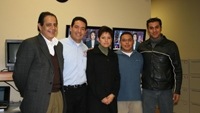The Vision MD/X series
Production switchers are loaded with more operational power than ever before. This added power often comes at a cost — a highly complex UI. A complex UI can be difficult to learn, and often only a few elite technical directors are able to access the power of some systems. This was a challenge tackled in the development of the Vision MD/X production switcher series.
Enhanced menu system ergonomics
The new menu system offers operators increased speed for live situations. DualDisplay provides space for two complete menu systems on one screen, allowing easy auto follow control on the bottom half and other tasks such as DVE box building or external device monitoring on the top. This can make building in preproduction more than twice as fast as single-menu systems by eliminating menu navigation steps.

Customizable quick-launch icons are always available on the left side of the screen to provide direct links to frequently used menus. Web browser-like back and forward buttons make it easy to get back to recently used menus.
In addition, smart haptic knobs have been added that allow the user to actually feel list items as they tick by. This enables TDs to get to their selections faster.
Finally, touch screen, mouse and dedicated physical menu buttons are available at the same time to support every user preference.
Product line modularity
The professional video industry's #1 source for news, trends and product and tech information. Sign up below.
The same control panel modules, rack frame boards and software are shared across the product line. This makes it easy for operators to confidently move between all switchers in the series without retraining.
Full modularity makes the small one-M/E switchers no compromise switchers with big switcher features such as mnemonics and upgradability. The switchers also act as working spares in case of a need for emergency parts for larger switchers in critical applications.
Four-M/E support
The fully modular approach in the hardware and software allows every panel size easy access to up to four M/Es in the rack frame. This can free up space in some mobiles and tight control rooms where panel space may be reduced but additional M/Es would be advantageous.
A one- or two-M/E control panel with full access to four M/Es is also useful for automated OverDrive applications, where the panel is often primarily used as a backup control surface but also needs to be able to build four M/Es.
Customizable RGB buttons
The buttons used in Vision were in development for more than four years. It was important to have just the right kind of feel. The buttons are equipped with RGB LEDs and are driven with 30-bit color. Any M/E can be configured to any user-defined color scheme.
In addition to allowing operators to customize their system, there is a practical application for the colors. The rack frame has up to 16 M/Es, with the combination of four main M/Es and 12 more mini M/Es called AuxKeys. Color-coding helps to distinguish the output M/E currently assigned to an M/E row on the control panel.
Integrated manuals
Product manuals never seem to be available when needed. Possibly the most time-saving aspect to the system was the integration of the 1500-page manual set into the switcher software. Using the DualDisplay menus, a tutorial can be read on the top menu and executed on the bottom.
After all, what good is a powerful switcher if the operators don't know how to take full advantage of its power?
David Ross is CEO of Ross Video.
